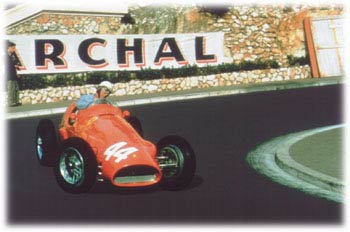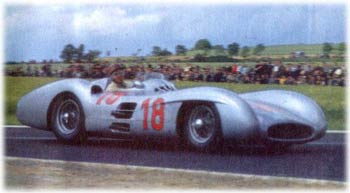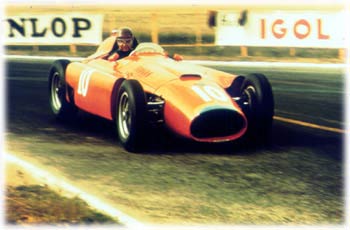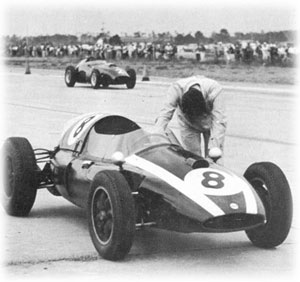The first season of Grand Prix racing already saw the establishment of basic principles which have not changed to this day. Formula One vehicles were constructions that were put on wheels for one reason alone: to win!
The unwritten Formula One asserted itself above all else at the beginning of the post-war Grand Prix era, and was formulated as follows with regard to racing car construction by the genius german constructor Ferdinand Porsche: "The perfect racing car crosses the finish line first and subsequently falls into its component parts." The philosophical background to this surprising piece of wisdom is that if the car is still functional after having done its work, then the constructor was guilty of using over-dimensioned components...
 Looking back, the cars of those days might appear to us to be completely unsuitable for their task. But to contemporaries they would have looked just like their grandchildren of the late-90s. They were technical miracles built for the purpose of earthbound flight, made up of chassis, cockpit, panelling, engine, tank and wheels - and nothing else!
Looking back, the cars of those days might appear to us to be completely unsuitable for their task. But to contemporaries they would have looked just like their grandchildren of the late-90s. They were technical miracles built for the purpose of earthbound flight, made up of chassis, cockpit, panelling, engine, tank and wheels - and nothing else!
There was one thing that the World Championship cars of the first generation had in common: the engine was at the front. But that's as far as engine similarities went. The rules allowed supercharged engines, in which the combustion chambers were filled with pre-compressed air by a supercharger. The capacity of the conventional induction engines was limited to 4.5 litres, that of the supercharged units to 1.5 litres.
Typically, the chassis was a tubular frame construction. The tank was positioned behind the driver's back and thus formed the rear end of the car. In this sense, the design was the same as that of the late 1930s. The overdue revolution in this sector was, however, already brewing. The pioneering Cisitalia-Porsche 360 construction with its mid-mounted engine never reached racing maturity for financial reasons.
The strongest team immediately proved to be Alfa Romeo, with the three "Fa's" under contract: Dr. Nino Farina, Juan Manuel Fangio and Luigi Fagioli. Between them, the trio won anything and everything, and Farina and Fangio became the first Champions respectively in Formula One history. In fact, Alfa did not suffer defeat until 1951, when the Argentinean Ferrari driver Froilan González beat off his rivals at Silverstone.
The most interesting construction of the early 1950s was undoubtedly the unsuccessful British BRM, whose daring concept never quite made it onto the grid on account of budget difficulties. The British team employed a traditional tubular frame chassis with a De-Dion rear axle for their national racing car. The engine was a 1.5 litre unit with 16 (!) cylinders. In theory, this power-pack was capable of delivering 615 HP at 12,000 rpm, but it fell short with 525 HP at 10,500 rpm, among other things because the SU carburettor was never replaced by the intended fuel injection system. Nevertheless, it still managed to exceed the engine power of the extremely successful Alfa Romeo 158 and 159 by more than 100 HP! The only problem with the sensational BRM type 15 was that it did not comply with Ferdinand Porsche's Formula: it fell into its component parts long before the finishing line had been reached.
 The engines could not be fuelled using conventional petrol because of the enormous thermal difficulties, particularly the supercharged units. As the regulations allowed free choice of fuel, the specialists from the oil industry mixed normal 'juice' with a goodly dose of alcohol for cooling purposes.
The engines could not be fuelled using conventional petrol because of the enormous thermal difficulties, particularly the supercharged units. As the regulations allowed free choice of fuel, the specialists from the oil industry mixed normal 'juice' with a goodly dose of alcohol for cooling purposes.
In the two racing years of 1952 and 1953, the Drivers' World Championship was contended in Formula Two cars with engines of up to 2000 cc. Just as Alfa Romeo had dominated the Grand Prix before, Ferrari now pulled ahead with its types 500 and 553 - Alberto Ascari winning victory after victory in the little cars. In 1952 the Italian triumphed six times and became champion. In the following year, when he defended the title successfully, he crossed the line five times in first place.
Because of its small cylinder capacity, the four-cylinder Ferrari developed no more than 190 HP, with which the limits of what was technically possible were already very close. Only Maserati managed to coax even more power out of their engines: with just over 200 HP, a new record for induction engines was set. The magic figure at last: 100 HP per 1000 cc of cylinder capacity.
In the chassis sector, the engineers stood still, and aerodynamics did not receive much attention either.
The 1954 season signalled the beginning of the 2.5 litre formula and with it a phase which brought the technical field of Formula One racing forward by three very important steps. The teams responsible for this were Mercedes, Connaught and Cooper.
The Germans entered the GP scene with a double victory. Juan Manuel Fangio came in first, just in front of Karl Kling. By the end of the following racing calendar, Mercedes had entered another eleven races and won another eight Grand Prix contests. Fangio was made champion in 1954 and 1955.
This man Fangio, who had already become world champion in 1951 with Alfa Romeo, had courted the legendary Mercedes race manager Alfred Neubauer with all manner of devices. And when 'Don Alfredo' finally invited him to Germany to negotiate a contract, he dug deep into the company's wallet and reserved a hotel room with an en-suite bathroom for the Argentinean superstar! Today's Grand Prix drivers are probably not even aware that hotel rooms without en-suite bathrooms ever existed...
The successful Mercedes engines had eight cylinders and a direct fuel injection system. The end was thus imminent for the carburettor engine, even if the Bosch direct injection system soon had to make way for the ingenious indirect manifold injection system. As is the case with today's F1 engines, you looked in vain in the Mercedes for valve springs. The valves were positively controlled by cam shafts and rocker levers in order to prevent flutter. Renault were the first to come up with the idea of using compressed air, more than thirty years later.
 All Formula One cars were still equipped with drum brakes, something we would now consider a thing of the Stone Age. The British Connaught team spearheaded the victory of the disc brake in 1955, as the English dentist Tony Brooks won the Syrakus Grand Prix in Italy, a race without World Championship status. However, it was a number of years before the whole field had completely re-equipped. In 1958, Ferrari mechanics removed the disc brakes from a Ferrari sports car during training for the Italian Grand Prix, and installed them in one of the Formula One cars.
All Formula One cars were still equipped with drum brakes, something we would now consider a thing of the Stone Age. The British Connaught team spearheaded the victory of the disc brake in 1955, as the English dentist Tony Brooks won the Syrakus Grand Prix in Italy, a race without World Championship status. However, it was a number of years before the whole field had completely re-equipped. In 1958, Ferrari mechanics removed the disc brakes from a Ferrari sports car during training for the Italian Grand Prix, and installed them in one of the Formula One cars.
Another innovation in Formula One crept in almost unnoticed on 16th July 1955, and had soon proven itself unbeatable. A certain Australian by the name of Jack Brabham appeared at Aintree in England, driving a Cooper whose 2 litre Bristol engine was mounted behind him. By 1959 this design had asserted itself so successfully that front-mounted engines were gone for good.
Up until the end of 1957 it was possible to choose freely what fuel you used. Mercedes, for example, relied on the following recipe: 45% benzene, 25% methyl alcohol, 23% aviation fuel, 3% acetone and 2% nitrobenzene. The remaining two percent remain a secret until this day. The explosive mixture was so aggressive that remnants left over from training and races had to be drained off and the engine rinsed out with conventional petrol. This was the only way to prevent the engine from suffering damage overnight!
From 1958 to the end of 1960, teams were compelled to tank up with aviation fuel with an octane rating of 130, after their oil sponsors, above all Shell, had urged Formula One to stipulate a more usual form of petrol so that the product transfer between the fans and Formula One was more effective and more convincing and health protection guaranteed.
 Even in those days a good idea was no guarantee of success, as two examples from Italy demonstrate. Alfa Romeo experimented with a four-wheel-drive car whose cockpit was positioned behind the rear axle. The Ferrari engineers brought a 2.5 litre two-cylinder (!) vehicle onto the test bed: it wasn't very powerful but it developed unbelievable torque.
Even in those days a good idea was no guarantee of success, as two examples from Italy demonstrate. Alfa Romeo experimented with a four-wheel-drive car whose cockpit was positioned behind the rear axle. The Ferrari engineers brought a 2.5 litre two-cylinder (!) vehicle onto the test bed: it wasn't very powerful but it developed unbelievable torque.
* * *
In those days the drivers were champions of traditional virtues, and their sportsmanship tended at times towards medieval chivalry. In 1956 for instance, Peter Collins, who was clearly on target for the title, handed his Ferrari over to his team colleague Fangio during the race at Monza. Without this generous gesture the Argentinean would never have won his fourth World Championship. In 1958, British Ferrari driver Mike Hawthorn was due to be disqualified after the Portuguese Grand Prix. Only a falsified statement by his most ardent adversary, Stirling Moss, prevented it from actually happening. When the points were finally added up, Moss was one short of becoming champion in place of Hawthorn. After that Moss never managed to win the World Championship title...